Europe, British Isles, England, Welsh March, Herefordshire, Hereford Cathedral [Map]
List of Bishops of Hereford Cathedral [Map].
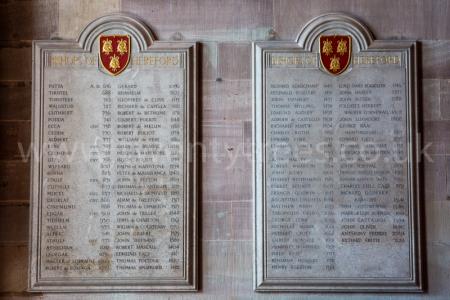
Choir Hereford Cathedral [Map].
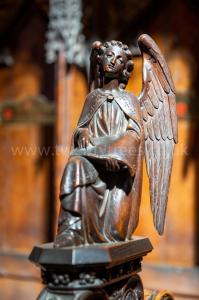
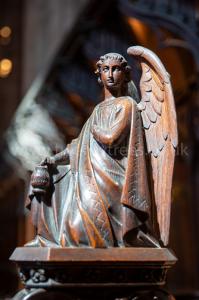
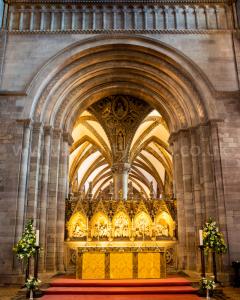
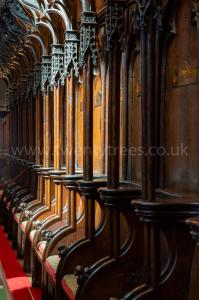
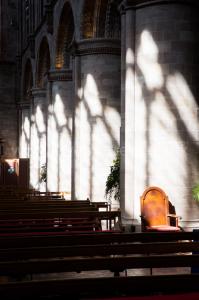
In 676 Bishop Putta was appointed Bishop of Hereford. There is some debate among historians as to whether there were two Putta's and whether the Putta that was Bishop of Hereford was a different person to the Putta that was Bishop of Rochester.
Between 1013 and 1016 Bishop Athelstan was consecrated Bishop of Hereford.
Anglo-Saxon Chronicle. 24 Oct 1055. This year died Earl Siward at York; and his body lies within the minster at Galmanho76, which he had himself ordered to be built and consecrated, in the name of God and St. Olave, to the honour of God and to all his saints. Archbishop Kinsey fetched his pall from Pope Victor. Then, within a little time after, a general council was summoned in London, seven nights before mid-Lent; at which Earl Elgar, son of Earl Leofric, was outlawed almost without any guilt; because it was said against him that he was the betrayer of the king and of all the people of the land. And he was arraigned thereof before all that were there assembled, though the crime laid to his charge was unintentional. The king, however, gave the earldom, which Earl Siward formerly had, to Tosty (age 29), son of Earl Godwin. Whereupon Earl Elgar sought Griffin's territory in North-Wales; whence he went to Ireland, and there gave him a fleet of eighteen ships, besides his own; and then returned to Wales to King Griffin with the armament, who received him on terms of amity. And they gathered a great force with the Irishmen and the Welsh: and Earl Ralph collected a great army against them at the town of Hereford [Map]; where they met; but ere there was a spear thrown the English people fled, because they were on horses. The enemy then made a great slaughter there-about four hundred or five hundred men; they on the other side none. They went then to the town, and burned it utterly; and the large minster [Map]77 also which the worthy Bishop Athelstan had caused to be built, that they plundered and bereft of relic and of reef, and of all things whatever; and the people they slew, and led some away. Then an army from all parts of England was gathered very nigh;78 and they came to Gloucester: whence they sallied not far out against the Welsh, and there lay some time. And Earl Harold (age 33) caused the dike to be dug about the town the while. Meantime men began to speak of peace; and Earl Harold (age 33) and those who were with him came to Bilsley, where amity and friendship were established between them. The sentence of outlawry against Earl Elgar was reversed; and they gave him all that was taken from him before. The fleet returned to Chester, and there awaited their pay, which Elgar promised them. The slaughter was on the ninth before the calends of November. In the same year died Tremerig, the Welsh bishop, soon after the plundering; who was Bishop Athelstan's substitute, after he became infirm.
Note 76 The church, dedicated to St. Olave, was given by Alan Earl of Richmond, about thirty-three years afterwards, to the first abbot of St. Mary's in York, to assist him in the construction of the new abbey. It appears from a MS. quoted by Leland, that Bootham-bar was formerly called "Galman-hithe", not Galmanlith, as printed by Tanner and others.
Note 77 Called St. Ethelbert's minster; because the relics of the holy King Ethelbert were there deposited and preserved.
Note 78 The place where this army was assembled, though said to be very nigh to Hereford, was only so with reference to the great distance from which some part of the forces came; as they were gathered from all England. They met, I conjecture, on the memorable spot called "Harold's Cross", near Cheltenham, and thence proceeded, as here stated, to Gloucester.
In Mar 1056 Bishop Leofgar of Hereford was consecrated Bishop of Hereford.
Anglo-Saxon Chronicle. 16 Jun 1056. This year Bishop Egelric resigned his bishopric at Durham, and retired to Peterborough minster [Map]; and his brother Egelwine succeeded him. The worthy Bishop Athelstan died on the fourth before the ides of February; and his body lies at Hereford [Map]. To him succeeded Leofgar, who was Earl Harold's mass-priest. He wore his knapsack in his priesthood, until he was a bishop. He abandoned his chrism and his rood-his ghostly weapons-and took to his spear and to his sword, after his bishophood; and so marched to the field against Griffin the Welsh king.79 But he was there slain, and his priests with him, and Elnoth the sheriff, and many other good men with them; and the rest fled. This was eight nights before midsummer. Difficult is it to relate all the vexation and the journeying, the marching and the fatigue, the fall of men, and of horses also, which the whole army of the English suffered, until Earl Leofric, and Earl Harold (age 34), and Bishop Eldred, came together and made peace between them; so that Griffin swore oaths, that he would be a firm and faithful viceroy to King Edward. Then Bishop Eldred took to the bishopric which Leofgar had before eleven weeks and four days.
Note 79. This was no uncommon thing among the Saxon clergy, bishops and all. The tone of elevated diction in which the writer describes the military enterprise of Leofgar and his companions, testifies his admiration.
John of Worcester. 16 Jun 1056. Athelstan, bishop of Hereford, a man of great sanctity, died on the fourth of the ides [the 10th] of February, at the episcopal vill called Bosanbyrig [Bosbury]; his body was carried to Hereford, and buried in the church [Map] which he himself had built from the foundations. He was succeeded by Leovegar, earl Harold's chaplain, who, on the sixteenth of the calends [the 16th] of June in the same year, together with his clerks and Ethelnoth the vice-reeve and many others, was massacred by Griffyth, king of Wales, at a place called Claftbyrig [Map]. He held the see only eleven weeks and four days. On his being thus cut off, the bishopric of Hereford was administered by Aldred, bishop of Worcester, until a successor could be appointed. This same bishop Aldred and the earls Leofric and Harold (age 34) afterwards reconciled Griffyth, king of Wales, with king Edward.
John of Worcester. 24 Jun 1070. The feast of St. John the Baptist being near, earl Asbiorn sailed to Denmark with the fleet which had wintered in the Humber; but his brother Sweyn (age 51) outlawed him, because he had accepted money from king William (age 42), to the great regret of the Danes. Edric, surnamed the Forester, a man of the most resolute courage, of whom we have spoken before, was reconciled with king William (age 42). After this, the king summoned from Normandy Lanfranc (age 65), abbot of Caen, a Lombard by birth, a man of unbounded learning, master of the liberal arts, and of both sacred and secular literature, and of the greatest prudence in counsel and the administration of worldly affairs; and on the day of the Assumption of St. Mary, appointed him archbishop of Canterbury, causing him to be consecrated at Canterbury on the feast of St. John the Baptist, being Sunday. He was consecrated by Giso, bishop of Wells, and Walter, bishop of Hereford, who were both ordained at Rome by pope Nicholas, when Aldred, archbishop of York, received the pallium,—for he evaded being ordained by Stigand, who then held the archbishopric of Canterbury, knowing him not to have received the pallium canonically. Bishop Heriman, who had already transferred the seat of his bishopric from Sherbourne to Salisbury, also assisted at his consecration, with some others. Afterwards, Lanfranc (age 65) consecrated Thomas, archbishop of York. The suit of the reverend Wulfstan (age 62), bishop of Worcester, was again prosecuted, there being now a bishop who could advocate the cause of the church of York; and the affair was, by the aid of God's grace, decided at a council held at a place called Pedred, before the king, archbishop Lanfranc (age 65), and the bishops, abbots, earls, and lords of all England. All the groundless assertions by which Thomas and his abettors strove to humble the church of Worcester, and reduce her to subjection and servitude to the church of York, were, by God's just judgement, entirely refuted and negatived by written documents, so that Wulfstan (age 62) not only recovered the possessions he claimed, but, by God's goodness, and the king's assent, regained for his see all the immunities and privileges freely granted to it by its first founders, the holy king Ethered, Oshere, sub-king of the Hwiccas, and the other kings of Mercia, Cenred, Ethelbald, Offa, Kenulf, Edward the Elder, Athelstan, Edmund, Edred, and Edgar.
On 29 Dec 1079 Robert the Lotharingian was consecrated Bishop of Hereford by Archbishop Lanfranc (age 74) at Canterbury Cathedral [Map].
On 26 Jun 1095 Robert the Lotharingian died. He was buried in the Choir Aisle at Hereford Cathedral [Map].
Robert the Lotharingian: On 29 Dec 1079 Robert the Lotharingian was consecrated Bishop of Hereford by Archbishop Lanfranc at Canterbury Cathedral.
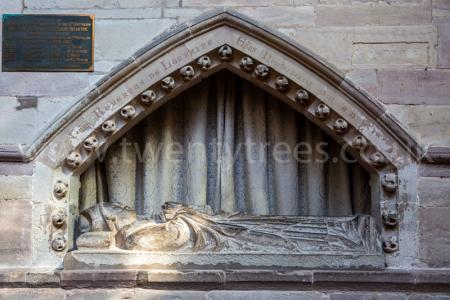
Around Dec 1102 Bishop Reynelm was nominated to be Bishop of Hereford. King Henry (age 34) invested Reynelm with the the temporalities of the see. This led to a dispute with Archbishop Anselm (age 69) who refused to consecrate Reynelm. Reynelm refused to be consecrated by Gerard, Archbishop of York so the King exiled Reynelm.
In 1115 Bishop Reynelm died. He was buried at Hereford Cathedral [Map].
Florence of Worcester Continuation. 07 Jan 1121. Meanwhile, two clerks were chosen to fill sees which had been vacant for some time; namely, Richard, who was keeper of the king's seal under the chancellor, and Robert, who had filled the office of steward of the meat and drink in the king's household with great industry. The first of these was preferred to the see of Hereford, the latter to the see of Chester [Note. Bishop of Coventry?]. Herbert, also, a monk of Westminster, was made abbot of that monastery.
Richard, chosen bishop of Hereford on Friday the seventh of the ides [the 7th] of January, was consecrated at Lambeth on Sunday the seventeenth of the calends of February [17th January] by Ralph, archbishop of Canterbury, with the assistance of Richard, bishop of London, and the bishops, Robert of Lincoln, Arnulph of Rochester, Urban of Glamorgan (age 45), and Bernard of St. David's.
Florence of Worcester Continuation. 12 Jun 1121. After a few days, one named Everard, attached to the king's chapel, was elected bishop of Norwich, and consecrated at Canterbury [Map] by archbishop Ralph on the second of the ides [the 12th] of June; Arnulph, bishop of Rochester, Richard, bishop of Hereford, and Robert, bishop of Coventry, having met for the purpose.
Florence of Worcester Continuation. 15 Aug 1127. Richard, bishop of Hereford, died at his vill, called Dydelebyrig [Map]1, on Monday the eighteenth of the calends of September [15th August]; his body was carried to Hereford [Map], and buried in the church there, with the bishops his predecessors.
In 1130 Bishop Robert de Bethune was appointed Bishop of Hereford.
Florence of Worcester Continuation. 03 Dec 1139. King Stephen at Worcester and Hereford. After these events, the king, with a large army, marched from Oxford to Worcester; and, having before his eyes what he had before heard of its disaster, he mourned over it. Halting there for three or four days, he conferred the dignity of constable, of which he had deprived Milo of Gloucester, on William (age 34), the son of Walter de Beauchamp, sheriff of Worcestershire.1 Here a report reached the king that his enemies, having violated their sworn promises of peace, had assaulted Hereford, and forced an entrance into the monastery of St. Ethelbert [Map], king and martyr, as if it had been a fortified castle. The king, therefore, put himself in march, and encamped at Little Hereford, or Leominster, where some of the inhabitants, taking counsel, swore fealty to him; while others refusing, sent him this message: "Although we will not swear, the king may, if he pleases, trust to the truth of our words." The holy days of Advent being close at hand [3rd December], a truce was agreed on between them, and the king returned to Worcester, where a certain clerk of eminent piety, Maurice by name, who had been elected by the clergy and people to the church of Bangor, was presented to the king at the castle, by Robert, bishop of Hereford, and Sigefrid, bishop of Chichester, who, bearing him company, attested his canonical election and fitness for the office of bishop; and the king confirmed the appointment. But being urged by the bishops to do homage to the king, he replied that he could in no wise do "There is," he said, "among us a man of great piety, whom I consider as my spiritual father, and who was archdeacon to my predecessor David, and he forbade me to take this oath." To which they made answer, "Reason requires that you should do we have done." Whereupon he said, "If you, who are men of high authority, have done this, I will not further hesitate to do the same." He therefore swore fealty to the king.
Note 1. See the preceding note. We are unable to account for this act of favour on the part of king Stephen to one of a family who were the most strenuous adherents of Henry I., his daughter the empress, and Henry III.; under all whom they held the offices of steward, sheriff of Worcestershire and Warwickshire, and constable. William de Beauchamp, fourth in descent from Walter, married Isabel, the heiress of William Mauduit, earl of Warwick; acquired that title in her right, and became the ancester of the powerful family of Beauchamp of Warwick. The earls Beauchamp of the present day are descended from Walter, of Powick, a younger son of William and Isabel.
On 22 Dec 1163 Bishop Robert Melun (age 63) was consecrated Bishop of Hereford by Archbishop Thomas Becket (age 44) at Canterbury Cathedral [Map].
In Mar 1173 Bishop Gilbert Foliot was elected Bishop of Hereford.
In 1186 Bishop William de Vere was appointed Bishop of Hereford.
The Itinerary of Archbishop Baldwin through Wales: Book 2 Chapter 13. From Wenloch, we passed by the little cell of Brumfeld,180 the noble castle of Ludlow [Map], through Leominster [Map] to Hereford [Map] leaving on our right hand the districts of Melenyth and Elvel; thus (describing as it were a circle) we came to the same point from which we had commenced this laborious journey through Wales.
Note 180. It appears that a small college of prebendaries, or secular canons, resided at Bromfield in the reign of king Henry I.; Osbert, the prior, being recorded as a witness to a deed made before the year 1148. In 1155, they became Benedictines, and surrendered church and lands to the abbey of St. Peter's at Gloucester, whereupon a prior and monks were placed there, and continued till the dissolution. An ancient gateway and some remains of the priory still testify the existence of this religious house, the local situation of which, near the confluence of the rivers Oney and Teme, has been accurately described by Leland.
Before 1200. Choir Aisle at Hereford Cathedral [Map] left to right ...
In 1198 Bishop William de Vere died.
On 09 May 1186 Bishop Gilbert Foliot died.
On 16 Apr 1148 Bishop Robert de Bethune died in Reims just after the closure of the Council of Reims. His remains were brought to Hereford Cathedral [Map] where he was buried. See Chronicle of Wigmore.
On 27 Feb 1167 Bishop Robert Melun (age 67) died.
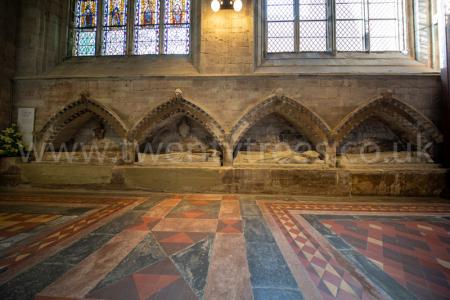
In 1200 Bishop Giles de Braose was appointed Bishop of Hereford.
by Mar 1231 Bishop Ralph de Maidstone was appointed Dean of Hereford Cathedral [Map].
Between 21 Aug 1234 and 30 Aug 1234 Bishop Ralph de Maidstone was elected Bishop of Hereford.
On 12 Nov 1234 Bishop Ralph de Maidstone was consecrated Bishop of Hereford by Archbishop Edmund Rich (age 59) at Canterbury Cathedral [Map].
On 27 Nov 1268 Bishop Peter Acquablanca died. Monument in the North Transept of Hereford Cathedral [Map] Low altar-tomb with moulded capping and plinth, and effigy in surplice, defaced head on cushion, feet on lion, remains of recumbent trefoiled canopy with crockets and trefoiled spandrels, drapery carefully rendered.
Bishop Peter Acquablanca: Bishop Peter Acquablanca was elected Bishop of Hereford. In 1263 John Giffard 1st Baron Giffard Brimpsfield was imprisoned Bishop Peter Acquablanca at Eardisley Castle.
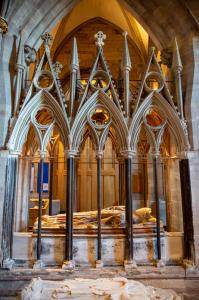
On 14 Jun 1275 Bishop Thomas Cantilupe (age 57) was appointed Bishop of Hereford.
On 08 Sep 1275 Bishop Thomas Cantilupe (age 57) was consecrated Bishop of Hereford.
On 25 Aug 1282 Bishop Thomas Cantilupe (age 64) died in Ferento, Orvieto. Monument in the North Transept of Hereford Cathedral [Map] in the form of a shrine-pedestal and consisting of an altar-tomb and open superstructure (Plate 134), altar-tomb possibly slightly earlier than the rest, tapering on plan and re-assembled, long sides with six bays and W. end with two bays of cinque-foiled arcading on attached shafts with foliated capitals and moulded bases, spandrels carved with varying naturalistic foliage; each bay filled with figure of knight (Plate 136) with long surcoat, heater-shaped shield and feet on lions and other beasts, faces all defaced; on slab, indent of brass figure of bishop with mitre and crozier and canopy; small brass figure of St. Ethelbert now in library; superstructure with six bays on long sides and two at W. end of open trefoiled arcading resting on shafts with moulded capitals and bases, spandrels carved with naturalistic foliage and winged beasts, moulded cornice at top and plain top slab; E. end of tomb, plain and not intended to be seen, with part of carved spandrel set in it.
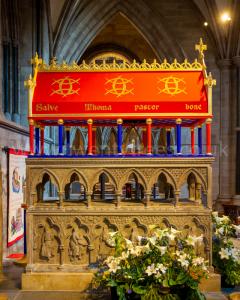
In 1294 John Swinfield Precentor was appointed Precentor Hereford.
In 1311 John Swinfield Precentor (age 17) died. Monument in North East Transept of Hereford Cathedral [Map]. Note the 'Swines' or pigs being a rebus on his surname. Effigy on plain altar-tomb in recess; effigy vested in cassock and surplice, drapery very carefully rendered, Doctor's cap on head; recess with moulded two-centred arch, enriched with ball-flower and swine, some with the arms of the Deanery on their bodies, moulded label with head-stops; remains of painted figure-subject on back of recess, formerly showing kneeling figure of doctor before the Virgin, with attendant figure, early 14th-century.
John Swinfield Precentor: Before 1294 he was born. In 1294 he was appointed Precentor Hereford.
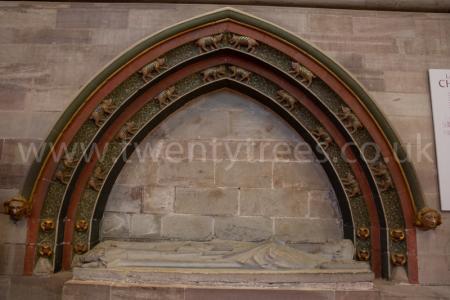
Around 1327. Lady Chapel of Hereford Cathedral [Map] Monument to Joan Plugenet of Kilpec, wife of Henry de Bohun, [1327], altar-tomb with effigy in wallrecess, plain altar-tomb with moulded top-edge enriched with Paterae and heads alternately, at head recumbent canopy with ogee cinque-foiled arch, crockets and finial; effigy of woman in wimple and veiled head-dress, tight sleeves and loose gown, head on cushion and feet on dog; all set in a 13th-century recess with moulded and segmental-pointed arch and label with head-stops and apex turned up to mitre with string-course of chapel; remains of black and red colour on effigy and arch, traces of painted figure and arch on back of recess and remains of decoration in spandrels of arch, including a diaper of fleur-de-lis and rosettes and two shields-of-arms (a) Plunkenet and (b) formerly Bohun but now obliterated.  Bohun Arms.
Bohun Arms.  Pye Arms.
Pye Arms.
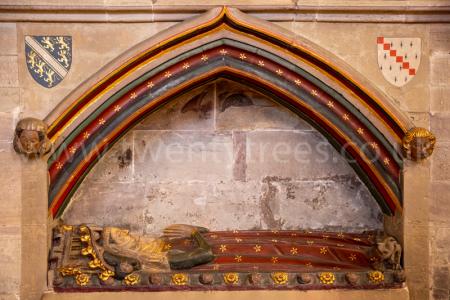
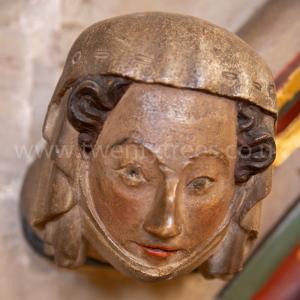
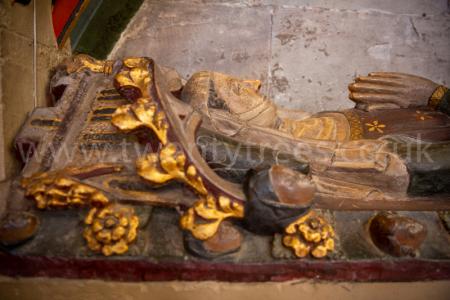
In 1327 Bishop Thomas Charleton was appointed Bishop of Hereford.
Before 18 Dec 1327 Joan Plugenet of Kilpec died. She was buried in the Lady Chapel of Hereford Cathedral [Map] where there is a monument. An Inventory of the Historical Monuments in Herefordshire, Volume 1, South west states: "In Lady chapel—against N. wall, (1) to [Joan (Plunkenet), wife of Henry de Bohun, 1327], altar-tomb with effigy in wallrecess, plain altar-tomb with moulded top-edge enriched with paterae and heads alternately, at head recumbent canopy with ogee cinque-foiled arch, crockets and finial; effigy of woman in wimple and veiled head-dress, tight sleeves and loose gown, head on cushion and feet on dog; all set in a 13th-century recess with moulded and segmental-pointed arch and label with head-stops and apex turned up to mitre with string-course of chapel; remains of black and red colour on effigy and arch, traces of painted figure and arch on back of recess and remains of decoration in spandrels of arch, including a diaper of fleur-de-lis and rosettes and two shields-of-arms (a) Plunkenet and (b) formerly Bohun but now obliterated"
Monumental Effigies. Humphrey de Bohun Earl of Hereford and Constable of England (Died 1321) in Hereford Cathedral [Map].
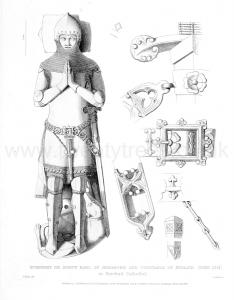
Monumental Effigies. Effigy in the Cloisters, Hereford Cathedral [Map].
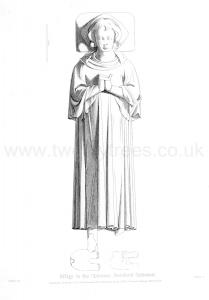
After 10 Aug 1358. Monument to Piers Grandison 2nd Baron Grandison. Lady Chapel of Hereford Cathedral [Map]. Mid 14th-century, altar-tomb with effigy and canopy, altar-tomb with range of cinquefoil-headed panels in front and panelled buttresses at ends carried up to the cornice of the canopy, effigy in mixed mail and plate-armour with camail and ridged bascinet, hauberk with scalloped lower edge, cyclas, enriched Hip Belt with dagger hanging in front and sword at side, head on cushions and feet on hound; recess with panelled back, moulded jambs and square head enriched with Paterae and trefoiled and sub-cusped pendant tracery below the head; vaulted soffit to canopy; canopy with range of six bays of open arcading with trefoiled and sub-cusped heads, crockets and finials, in arcading two headless figures of the Coronation of the Virgin, headless figure with book, archbishop with cross-staff, St. John the Baptist holding a roundel with the Agnus Dei, and a bishop, last four figures brought from elsewhere; canopy finished with enriched cornice and pierced parapet with quatrefoils and cusped cresting.
Piers Grandison 2nd Baron Grandison: he was born to William Grandison 1st Baron Grandison and Sibylla Tregoz Baroness Grandison at Ashperton, Ledbury. On 27 Jun 1335 William Grandison 1st Baron Grandison died at Lambourne. His son Piers Grandison 2nd Baron Grandison succeeded 2nd Baron Grandison. Blanche Mortimer Baroness Grandison by marriage Baroness Grandison. In or before 1340 Piers Grandison 2nd Baron Grandison and Blanche Mortimer Baroness Grandison were married. She the daughter of Roger Mortimer 1st Earl March and Joan Geneville Baroness Mortimer 2nd Baroness Geneville. She a great x 4 granddaughter of King John "Lackland" of England. On 10 Aug 1358 Piers Grandison 2nd Baron Grandison died at Ashperton, Ledbury. His brother Bishop John Grandison 3rd Baron Grandison succeeded 3rd Baron Grandison.
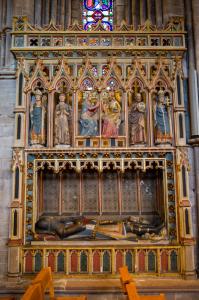
On 17 Mar 1360 Archbishop William de Courtenay (age 18) was consecrated Bishop of Hereford.
On 12 Mar 1375 Bishop John Gilbert was translated to Bishop of Hereford.
On 26 Jul 1375 Richard Pembridge (age 55) died. Hereford Cathedral [Map]. Alabaster altar-tomb and effigy, altar-tomb with moulded base and capping, sides and ends panelled with alternate quatrefoils enclosing shields of his arms and trefoil-headed panels; effigy in bascinet, Camail and Jupon Period. His jupon with same arms as his shield. Hip Belt, Leg Garter, right leg modern, head on helm crested with a Feathered Crest, feet on hound.
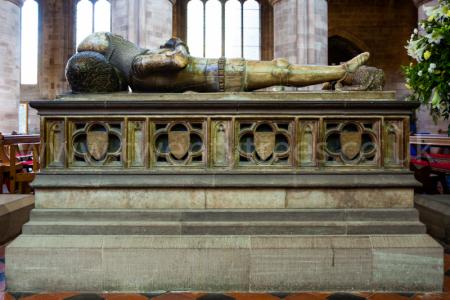
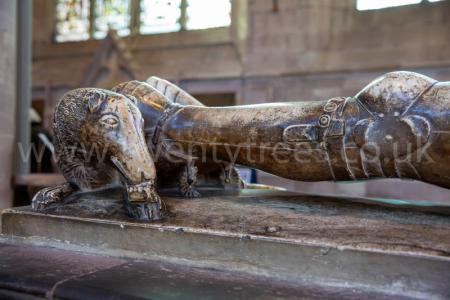
Monumental Effigies. Sir Richard Pembridge KG (died 1375) in Hereford Cathedral [Map].
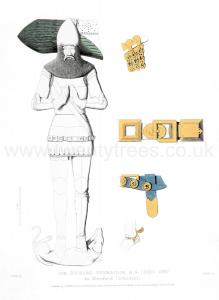
In 1435 Richard Delamere died, and Isabel his wife, died 1421. Monument in the North Transept of Hereford Cathedral [Map]. Figure of man in plate armour, feet on lion, figure of lady in horned headdress and SS collar, two dogs at feet, double canopy with cinque-foiled and sub-cusped arches and crocketted ogee gables and upper cornice, parts of standards and pinnacles missing, foot inscription and three shields-of-arms (a) Delamere, (b) the same impaling Acton.
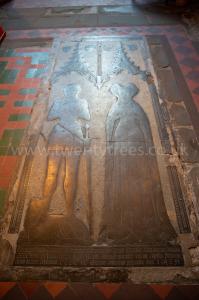
In 1448 Bishop Richard Beauchamp (age 27) was appointed Bishop of Hereford.
On 22 Jun 1492 Bishop Edmund Tuchet (age 49) was appointed Bishop of Hereford.
In 1504 Bishop Richard Mayew (age 64) was appointed Bishop of Hereford.
On 16 Oct 1514 Richard de la Bere died. Brass. Figures of man in plate armour with head on helm, and of two wives in pedimental head-dresses with long girdles, groups of four daughters and one son of first wife and ten sons and six daughters of second wife, names of two daughters, three shields-of-arms. South East Transept of Hereford Cathedral [Map].
Richard de la Bere: Before 1498 he and Anne Tuchet were married. One son, four daughters. She a great x 5 granddaughter of King Henry III of England. After 1503 he and Elizabeth Mores were married. Ten sons, six daughters.
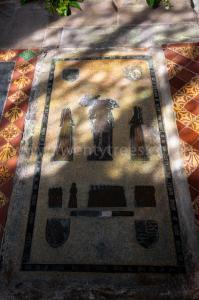
In 1516 Bishop Richard Mayew (age 76) died. He was buried between the Choir Aisle at Hereford Cathedral [Map] and the Choir.
Bishop Richard Mayew: In 1440 he was born in Hungerford. His surname sometimes Mayo. In 1493 he was appointed Archdeacon of Oxford. In 1501 Bishop Richard Mayew travelled with Catherine of Aragon Queen Consort England on her journey from Spain to England. In 1504 he was appointed Bishop of Hereford.
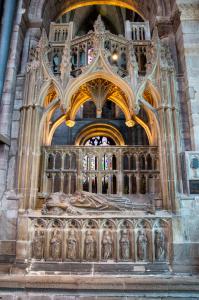
On 20 Aug 1535 Bishop Edward Fox (age 39) was elected Bishop of Hereford.
In 1541 Archbishop Hugh Curwen (age 41) was appointed Dean of Hereford.
On 26 May 1553 Bishop John Harley was consecrated Bishop of Hereford.
On 01 Mar 1554 Bishop Robert Parfew aka Warton was translated to Bishop of Hereford.
On 19 Mar 1554 Bishop John Harley was deprived of his see of Bishop of Hereford for being a Protestant, and because he was married.
On 01 Apr 1554 the Lord Chancellor Bishop Edmund "Bloody" Bonner of London (age 54), assisted by Bishop Stephen Gardiner (age 71), Bishop Nicholas Ridley (age 54) and Bishop Cuthbert Tunstall (age 80), consecrated seven bishops at Southwark Cathedral [Map]:
Bishop George Cotes was consecrated Bishop of Chester.
Bishop Gilbert Bourne was consecrated Bishop of Bath and Wells.
Bishop James Brooks (age 41) was consecrated Bishop of Gloucester.
Bishop Maurice Griffiths (age 47) was consecrated Bishop of Rochester.
Bishop Henry Morgan was consecrated Bishop of St David's.
Bishop John White (age 44) was consecrated Bishop of Lincoln.
Bishop Robert Parfew aka Warton was consecrated Bishop of Hereford.
Henry Machyn's Diary. 01 Apr 1554. [The first day of April my lord chancellor (age 54) did consecrate six new bishops at St. Mary Overy's [Map], before the high altar; and a goodly mass was said. And when all] was done thay yede unto my lord ch[ancellor's,] for ther was as grett a dener as youe ha[ve seen.] Thes be the bysshopes names that wher consecrated, [doctor] Whyt (age 44), warden of Wynchastur, the bysshope of Ly[ncoln]; doctur Borne, bysshope of Bathe; doctur Morgan, bishop of sant Davys; doctur Brokes (age 41), bysshope of Gloss [ter]; doctur Cottes, bysshope of Westtchastur; bysshope of sant Asse changyd to be bysshope of Arfford; master [Griffith] (age 47) parsun of sant Magnus bysshope of Rochastur.
In 1559 Bishop John Scory (age 49) was elected Bishop of Hereford.
In 1634 Bishop Matthew Wren (age 48) was appointed Bishop of Hereford.
In Jul 1636 Bishop George Coke (age 65) was translated to Bishop of Hereford.
After 10 Dec 1646 a cenotaph to Bishop George Coke (deceased) was erected in his memory in the South East Transept of Hereford Cathedral [Map]. Effigy in Rochet, chimere, ruff and skull-cap, head on tasselled cushion, base and canopy modern.
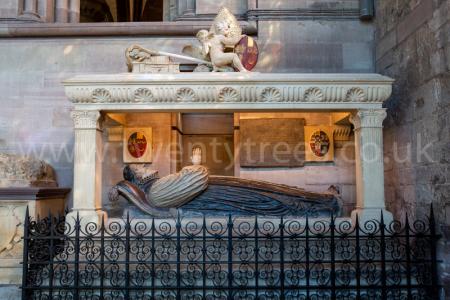
In 1661 Bishop Herbert Croft (age 58) was appointed Bishop of Hereford.
On 06 Jan 1661 Bishop Nicholas Monck (age 51) was consecrated Bishop of Hereford.
Evelyn's Diary. 20 Feb 1676. Dr. Gunning (age 62), Bishop of Ely, preached before the King (age 45) from St. John xx. 21, 22, 23, chiefly against an anonymous book, called "Naked Truth", a famous and popular treatise against the corruption in the Clergy, but not sound as to its quotations, supposed to have been the Bishop of Hereford and was answered by Dr. Turner, it endeavoring to prove an equality of order of Bishop and Presbyter.
In 1713 Bishop Philip Bisse (age 46) was appointed Bishop of Hereford.
In 1723 Bishop Henry Egerton (age 33) was appointed Bishop of Hereford.
On 03 Apr 1768 Velters Cornewall of Moccas in Herefordshire (age 71) died. He was buried at Hereford Cathedral [Map]. A monument to his memory was erected on the South wall of the Nave. It was moved to the cloister as part of the renovations.
In 1787 Bishop John Harley (age 58) was appointed Bishop of Hereford.
In 1808 Bishop John Luxmoore (age 42) was translated to Bishop of Hereford.
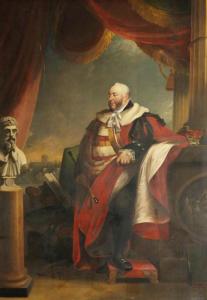 1819. James Lonsdale (age 41). Portrait of Charles Howard 11th Duke of Norfolk looking over the Wye Bridge [Map] and Hereford Cathedral [Map].
1819. James Lonsdale (age 41). Portrait of Charles Howard 11th Duke of Norfolk looking over the Wye Bridge [Map] and Hereford Cathedral [Map].
On 20 May 1832 Bishop Edward Grey (age 49) was consecrated as Bishop of Hereford.
Archaeologia Volume 32 Section VII. Account of the Opening of the Coffin of Joanna de Bohun, in the Lady Chapel of Hereford Cathedral [Map]. By the Very Rev. John Merewether (age 49), D.D. Dean of Hereford. Read llth June, 1846.
On 04 Apr 1850 John Merewether (age 53) died. He was buried in the Lady Chapel of Hereford Cathedral [Map]. The five lancet windows at the east end of the minster were fitted with stained glass to his memory with the inscription In Memoriam Johannis Merewether, S.T.P. ecclesiæ Heref. decani, quo strenuo fautore huius sacræ ædis restitutio feliciter est inchoata ie. In Memory of John Mereweather (age 53) dean of Hereford whose energetic support the restoration of this sacred edifice was successfully begun.
In 1867 George Herbert (age 41) was appointed Dean of Hereford which office he held until his death in 1894.
In 1868 Bishop James Atlay (age 50) was appointed Bishop of Hereford.
On 24 Dec 1894 James Atlay Bishop of Hereford 1817-1894 died. Monument in the North Transept of Hereford Cathedral [Map]. Sculpted by James Forsyth (age 66).
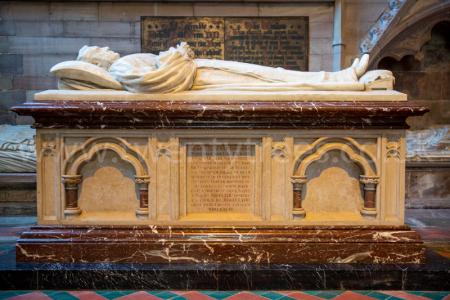
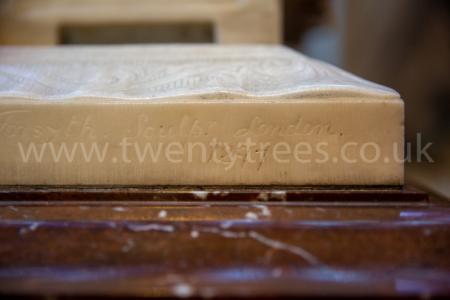
In Jan 1895 John Percival Bishop (age 60) was elected Bishop of Hereford by Archibald Philip Primrose 5th Earl Rosebery 1st Earl Midlothian (age 47).
On 03 Dec 1918 John Percival Bishop (age 84) died. Monument sculpted by Allan Gairdner Wyon (age 36) in the Choir of Hereford Cathedral [Map].
John Percival Bishop: On 27 Sep 1834 he was born in Brough Sowerby Kirkby Stephen. In Jan 1895 John Percival Bishop was elected Bishop of Hereford by Archibald Philip Primrose 5th Earl Rosebery 1st Earl Midlothian.
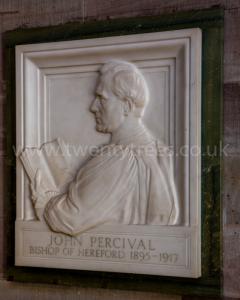
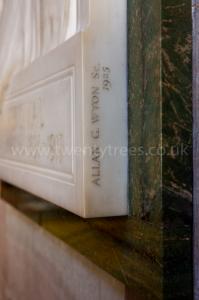
Bishop James Beauclerk was appointed Bishop of Hereford.
Bishop Peter Acquablanca was elected Bishop of Hereford.